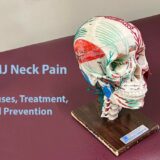The Dental CBCT: Why You Need More Than a Standard X-Ray

Dental Cone Beam Tomography Scans and Why you Benefit from a Current X-Ray
Updated 1.16.2023
You had an x-ray at the dentist’s office years ago. However, you need a current dental x-ray.
You still remember seeing the strange contrast of your teeth against the black background. But the last time you had a dental check-up, your dentist recommended having a cone beam CT scan (CBCT).
What is a CBCT x-ray?
A CBCT x ray is a one beam computed tomography, also known as C-arm CT, cone beam volume CT, or flat panel CT. It is a modern medical imaging technique that comprises X-ray computed tomography where the X-rays are divergent, forming a cone.
The machine looked totally different and it made you feel uneasy. However, when suffering from orofacial pain, should you have it checked out by a professional? Is all this really necessary?
Ho, you may have questions.
TMD is the only musculoskeletal disorder of the head and neck that causes pathological changes in an individual’s both soft tissue and hard tissue. CBCT or CT has proved valuable for evaluating TMJ bony changes such as erosion and osteophyte. We find that MRIs are more useful for evaluating disc morphology, internal disc derangement, joint effusion, and soft tissue changes. During the process of TMJ disease onset, soft tissues of TMJ are affected in the earlier stage and hard tissues are more commonly affected in the later stage. Therefore, MRI is best suitable for evaluating early-stage, and CBCT or CT is suitable for late-stage TMD evaluation. CBCT and CT accuracy were comparable in detecting surface changes in the bone and CBCT required less radiation exposure.
This is why we advocate for CBCT use for imaging TMJ with suspected osseous surface changes.
What’s the difference between a CBCT scan and a standard x-ray?
The difference between an X-ray and CBCT Scan is minor. Where the between X-ray and CT scan is notable is that X-ray is used to detect bone fractures and dislocations. They may also detect pneumonia, cancers, and more. Images produced by X-ray are in 2D, whereas in CT scans the doctors gain 3D images.
What Are the Different Types of Dental X-Rays?
The gold standard in dentist offices up and down the country used to be the standard x-ray. Now, technologies have moved on, and dentists have a wider range of imaging machines to choose from.
Intraoral x-rays along with the panoramic x-ray are the old standard, and extraoral x-rays are the new guard – often used to detect TMJ and Airway problems in the jaw and throat. For the purpose of brevity, I have not gone into detail with every extraoral imaging machine, but here I cover the main types.
Main Types of Dental Imaging Machines
1. Intraoral
- Periapical x-rays: the most common type of x-ray taken at the dentist’s office, these x-rays show the whole tooth – usually in clusters in one portion of your upper or lower jaw. Because this is a pinpoint technique, it’s not suitable to image your entire mouth.
- Bite-wing x-rays: this is an image of both the upper and lower teeth in one area of your mouth. Each image shows the dentist your teeth from the crown to the supporting bone of the jaw.
- Occlusal x-rays: this is used to map and find any changes in the shape of your arches in either the upper or lower jaw.
2. Extraoral
- Tomograms: a specialized type of x-ray that shows a particular layer of your mouth, helpful for dentists to examine specific structures normally hidden, but rarely used today.
- Panoramic x-rays: the classic image of all your teeth in both your upper and lower jaw. The image is a convenient way for your dentist to see everything on a single x-ray, helping them to spot emerging teeth, impacted teeth, and possible tumors.
- Dental computed tomography (CT): game-changing imaging that allows your dentist to look at the interior of your mouth in 3D. The imaging helps your dentist find cysts, tumors, and fractures.
- Cone beam computed tomography (CBCT): also creates 3D images, but displays soft tissue, airway, and bone as well as dental structures. Using CBCT your dentist can evaluate tooth implant placement, and discover issues with your gums and teeth roots, jaw, as well as tonsils, adenoids, deviated septum and enlarged turbinates.
- MRI imaging: a type of 3D imaging that is useful for soft tissue evaluation of the oral cavity.
What Is the Difference Between CBCT and CT?
Dental CT and cone beam CT are types of x-ray that created 3D images of your mouth. CBCT cuts the radiation exposure dramatically when compared to medical CT. Both forms are superior to the intraoral panoramic x-rays, as they help your dentist in doing the following:
- Providing accurate measurements, including shape and dimensions of your jaw – which is useful for dental implant surgery, and taking measurements for oral appliances.
- Detecting lesions that may indicate serious disease.
- Diagnosing airway sleep disorders.
- Identifying the precise location of an infection in your tooth.
- Evaluating your sinuses, nasal cavity, and nerve canal.
Dental CT is an older technology, invented in the early 70s, that uses fan-shaped x-ray beams that move around as the patient advances in the machine. Dental cone beam CT was invented n the 90s, and the technology is based on light intensifier technology. Cone beam CT uses a cone-shaped area detector which means the patient can stay static as the sensor moves around them.
The advantages of CBCT over CT is that the machine is more compact and therefore can be included in most dentistry practices – much more convenient than having to visit a separate imaging center. But also the patient receives a lower dose of radiation, and the procedure is also much quicker.
What Can a Dental CBCT Scan Help Diagnose?
As a dental CBCT x-ray can give your dentist an in-depth view of your teeth, jaw, gums, nerves, and sinuses – it can help detect and diagnose many diseases.
Diseases and complications that may impact TMJ include:
- Airway sleep disorders such as sleep apnea
- TMJ
- Bone cancer, tumors, or cysts
- Fractures
- Tooth root infections, root canals, or other problems with the core of the tooth
- Gum problems
- Nasal Anatomy, include: septum, turbinates and sinuses.
A cone beam CT scan is the easiest, quickest route to your dentist being able to diagnose conditions affecting your jaw, gums, and breathing. The sooner you get your diagnosis, the quicker your dentist is able to come up with a plan of treatment. The sooner you gain pain relief.
Preparing for a Dental CBCT Scan
It’s very straightforward to prepare for your dental cone beam CT scan, and you won’t be in the chair for long. Pregnant women must warn their dentist before going ahead with the procedure, but otherwise, there are no major medical risks – and you don’t need to take any medicines or require any recovery time. Gain a better understanding by reading our FAQ page.
To prepare for your CBCT scan:
- Remove any hearing aids and/or glasses.
- Take off all metal jewelery and hair decorations including –
- Earrings, nose or tongue studs, and other facial piercings
- Necklaces
- Hair clips
- Remove dentures
“When joints were divided into four groups in terms of the co-occurrence of CBCT and MRI findings, Type I (neither CBCT nor MRI findings) was 7.6%. Type I most likely reflects problems with masticatory muscles, such as temporal muscles and masseter muscles, rather than internal derangement of the joint.
Type III (only MRI findings) were more common in all three clinical symptoms (sound, pain and limited mouth opening) than in type II (only CBCT findings). This shows that MRI may be more useful than CBCT for all three of these clinical symptoms. These results indicate that MRI may be preferable over CBCT for symptomatic TMD patients when suitable imaging guidelines are not judged. In particular, MRI was more useful than CBCT for the symptom of sound. MRI is superior to CBCT (CT) images for the diagnosis of TMJ internal derangement.” – Comparison of the Usefulness of CBCT and MRI in TMD Patients According to Clinical Symptoms and Age, 2020
CBCT and MRI play complementary roles in the evaluation and diagnosis of TMD; both are useful imaging modalities. Pain clinicians typically perform MRIs first when the clinical symptoms are related to internal derangement, soft tissue, or the early stage of the disease. MRI is also recommended as the first-line imaging modality in younger chronic pain patients or if it is unclear which imaging modality is more suitable. This often helps to detect a hidden TMJ disorder or the best treatment for headaches.
Cory Herman, DDS MN, Eric Schiffman, MN DDS, and MN Head and Neck Clinic pain health coaches regularly use imagery from cone beam CT x-rays to pinpoint jaw and breathing issues that may contribute to airway sleep disorders in my patients. A CBCT scan also facilitates accuracy when fitting patients with a tailored sleep appliance, to open up the airway, which offers improved sleep patterns. The cone beam CT scan is a modern and efficient way for dentists to evaluate their patients – an essential piece of equipment for any dentist office.



One comment
Pingback: Best car accessories, Car accessories online, Affordable car accessories,Top-rated car accessories, Car accessories for sale, Custom car accessories, Car interior accessories, Car exterior accessories, Car gadgets and accessories, Car accessories shop nea